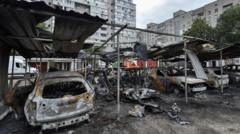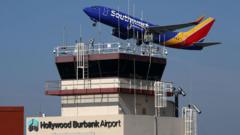The tragic mid-air collision involving a military helicopter and a passenger plane in Washington, DC, which resulted in 67 fatalities, is prompting significant scrutiny into air traffic control staffing practices. Transportation Secretary Sean Duffy recently acknowledged that staffing was "not normal" at the time of the incident, emphasizing the need for a thorough review of current operational procedures.
Air Traffic Control Understaffing Raises Questions Following DC Crash

Air Traffic Control Understaffing Raises Questions Following DC Crash
Investigation into the fatal mid-air collision highlights longstanding issues in air traffic control staffing.
Reports indicate that at the time of the crash, the Reagan National Airport tower was understaffed, with a single air traffic controller managing both helicopters and commercial flights—a task typically handled by two controllers. Duffy stated that there was a "consolidation of air traffic controllers" just prior to the incident, raising questions about whether traffic was directed appropriately in adherence to FAA policies. Furthermore, the National Transportation Safety Board (NTSB) revealed that the helicopter was operating at a flight ceiling of 200 feet, which is the maximum altitude allowed in that region.
Duffy expressed concern about the timing of the helicopter's mission, questioning why it was conducted during peak air traffic hours instead of at a later time when fewer flights would be in the air. Investigators are currently looking into various factors surrounding the crash, including operational altitude and the potential mismanagement of air traffic.
This incident highlights a significant and ongoing issue with air traffic control in the US, where more than 90% of facilities are reportedly operating below the FAA's recommended staffing levels. Duffy acknowledged that the nation has struggled with air traffic controller shortages for years, leading to increased stress and workload for existing staff. As he collaborates with the FAA to formulate a plan to address these staffing challenges, Duffy notes the complexities of rapidly training new air traffic controllers.
The national conversation about air traffic safety is reigniting as victims' families gather to pay respects at the crash site, reflecting the urgent need for policy changes to ensure air travel safety in the United States.
Duffy expressed concern about the timing of the helicopter's mission, questioning why it was conducted during peak air traffic hours instead of at a later time when fewer flights would be in the air. Investigators are currently looking into various factors surrounding the crash, including operational altitude and the potential mismanagement of air traffic.
This incident highlights a significant and ongoing issue with air traffic control in the US, where more than 90% of facilities are reportedly operating below the FAA's recommended staffing levels. Duffy acknowledged that the nation has struggled with air traffic controller shortages for years, leading to increased stress and workload for existing staff. As he collaborates with the FAA to formulate a plan to address these staffing challenges, Duffy notes the complexities of rapidly training new air traffic controllers.
The national conversation about air traffic safety is reigniting as victims' families gather to pay respects at the crash site, reflecting the urgent need for policy changes to ensure air travel safety in the United States.





















